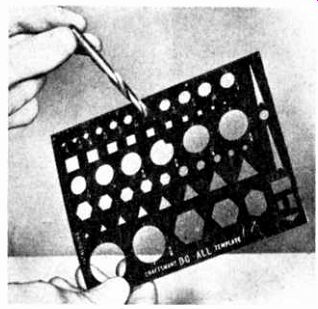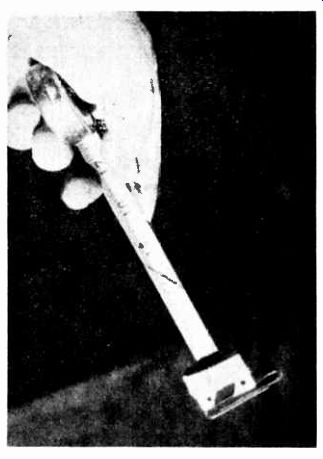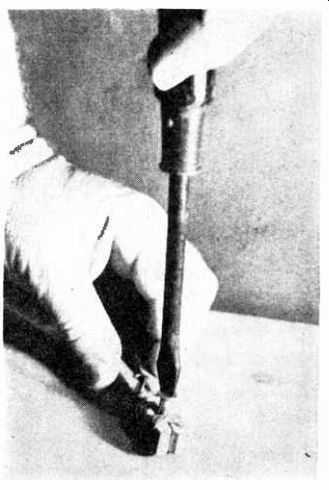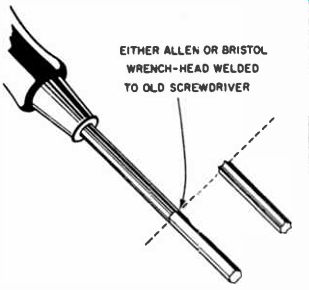Screwdriver Improvement
Considerable burring of all types of Phillips-head screws often results from slippage of the Phillips-head screwdrivers. The slippage may be decreased considerably by filing down the tips of the no. 1 and no. 2 screwdrivers about 1/32 in. This measure will insure better traction in the screw heads.
Nut Driver Extension
I ran into a situation in which I had trouble removing a high-voltage cage. Because of the location of the cage in a tight spot, I would have needed a nut driver with a shaft at least 6 in. long to get to the 1/4-in. hex-head screws that were securing the cage to the chassis. My 1/4-in. nut driver has a shaft only 3 in. long.
I procured a length of separate shaft 4 in. long, which I was able to fit snugly into the head of the nut driver. At the outer end of the shaft extension, I connected another 1/4-in. socket head. This made the nut driver more than long enough to do the job. Incidentally, any size socket head can be secured to this type of shaft for different types and sizes of nuts. Sets of these heads and shafts are available in hardware stores.
Tool Mounts in Tube Caddy
The service technician's tube caddy never has enough space for all the equipment required for home calls. The space on the removable lid in caddies of certain types is often overlooked as a possible place to mount hand tools. I find that rubber stand-off insulators provide a quick, easy method of holding long-nose pliers, diagonal cutters and similar tools in place on the lid.
When the lid is up and the caddy is closed, these tools hang securely with their handles up and fit snugly into the openings of the standoffs.
When the lid is open, as shown in sketch, the tools slip easily down and out of the holders.

LID SHOWN IN OPEN POSITION

Draftsman's template checks drill sizes.
Versatile Draftsman's Aid A template of the kind used by draftsmen, made of heavy celluloid and containing openings of various sizes and shapes (as shown in the photograph) has many uses in the service shop. The template illustrated here is about 4 by 5 in. and has circular openings that are very close to common drill sizes. These openings are very convenient for accurately checking drill points. While the circles were not intended for this purpose, they provide an additional function for an already useful aid.
These templates may be purchased from any office supply stores:
Smooth Chassis Holes
A round file serves as an effective reamer when it becomes necessary to make or enlarge holes in metal chassis, without introducing the danger of tearing the metal. To get a clean hole of the right size, drill a hole just large enough to admit the small end of the file. Next, chuck the file in a brace, and turn it counterclockwise into the hole, with a light feed. Turning it in this direction prevents the right-handed cut of the file teeth from binding in the hole.
Insulated Screwdriver
A piece of rubber tubing or plastic hose slipped over the shank and tip of a screwdriver serves as a screw-holder and insulator. It can be used to pry control knobs loose. The tubing also acts as padding to prevent scarring.
Long Handle Tweezers
Tool users occasionally need tweezers with a greater reach, more stable holding action, or stronger gripping power. When needed, it is a simple matter to meet these requirements in the following manner:
Tape a tweezer to one jaw of a needle nose pliers or spring type clothespin, as illustrated.
The tweezer should he positioned between the jaws of a plier or clothespin so their jaws are closed when the tweezer jaws are closed, and vice versa.

-------- A simple extension tool can be devised to get those inaccessible
screws, nuts, etc., by taping tweezers to long-nosed pliers or a spring-type
clothes pin.
When using the clothespin arrangement, no pressure is required from the hand or fingers to maintain the tweezer's grip.
This arrangement provides a handy tool--quickly improvised--for picking up small objects from inaccessible places.

--- Ordinarily used for cutting control shafts, this popular jig can double
as a "third hand" when lying idle.
Versatile Jig
A commercially available jig for cutting control shafts can be adapted to many other uses by the technician. The example below illustrates two practical shop applications.
By mounting a control in the jig, it is easy to remove excess solder or straighten lugs.
When not being used for its original purpose, the jig can also serve as a solder dispenser. A large spool of rosin-core solder handles well when placed between the two upright sections as shown. The solder can then be pulled through one control opening, as needed.

--- A small magnet attached to the end of a steel tape can retrieve lost
objects from various inaccessible places and is instantly adjustable to the
required length.
Allen Wrench Assist
We keep some very thin automobile shim stock around the shop, for use in removing Allen set screws that have become rusted or otherwise so firmly seated, that removing them may require a major job (particularly when the Allen wrench cannot grip the screws). Clean out the set screw head with a piece of stiff wire, then place a small piece of the shim stock over the head of the Allen wrench. Now tap the wrench into the opening in the screw head.
This provides a firm grip for the wrench and often eliminates a time-consuming and irksome chore.
Handy Retriever
When small screws, washers, nuts, clips or similar objects drop into an inaccessible place, such as a TV or radio chassis or cabinet, they can be quickly recovered with a small magnet attached to the end of a steel tape, as shown above. The magnet is fastened to the end of the tape by means of a rubber band or masking tape. If the article to be recovered is non-magnetic fasten a bit of masking tape, sticky side out, to the end of the tape and this will pick up any small objects. Also, it is extremely useful for removing lost washers from the shell of a speaker or from the speaker housing.

---- A color coded pressure-tape "flag" attached to alignment
tools, prevents their rolling from bench top. Locating tools is simplified
in cluttered surroundings.
Flag That Tool!
Small often used tools have a habit of "disappearing" when you need them most. A favorite, much used adjusting tool can roll off your test bench or desk. Perhaps it became hidden in a clutter of tools and small parts on the work bench. To quickly end this problem, "flag" the alignment tool, probe or pen with a bit of pressure tape, as shown below. A band of tape is placed near one end of the tool, with the tape ends squeezed together, to make a flag. This flag prevents the tool from rolling when it is placed on a flat surface. A daub of red paint or other color code on the flag will make a popular tool easy to spot at a glance if it's buried among other tools.

--- Spring-type clothespin saves fingers when starting screws and short
nails.
Screw Holder
After a few exasperating, not to say painful experiences with a slashed thumb or forefinger, I devised a method for starting wood screws without a starting hole by clamping the screw between the jaws of a spring-type clothespin, as shown above. For a tighter grip, twist a heavy rubber band around the jaws of the clothespin. When starting screws in soft wood the rubber band is unnecessary. This method is also a finger tip saver if used when driving short nails or brads. They can be started against the wood, in close quarters, above the head without difficulty and with no danger of smashing your finger.
"Tweezers" for Bearings

--- Home-made tweezer lifts ball bearings easily.
In replacing elusive, small ball bearings, like those used in variable tuning condensers, the tiny bearings are more easily handled with a pair of "tweezers" fashioned from a 10-in. length of no. 14 bare copper wire.
Form a small eye in each end of the wire (as in the accompanying illustration), then bend the wire in a U-shape so that the two eyes line up when the tweezer is pinched together. In use, the eyes fit against the curved surfaces of the balls and grip them far more positively than fingers can.

---- Speed wrench driver for Allen or Bristol screws can be easily made
from an old screwdriver.
Allen-Wrench Driver
There are many Allen and bristol set screws in out of the way places which are difficult to reach. Sometimes it is even necessary to dismantle some of the equipment just to expose one of these screws. There are times when an extension or handle can provide extra reach and leverage. A simple solution is to weld part of an alien or bristol wrench on to the end of a spare screw driver.